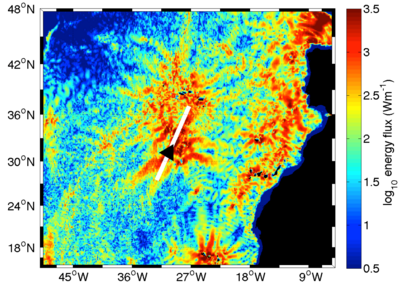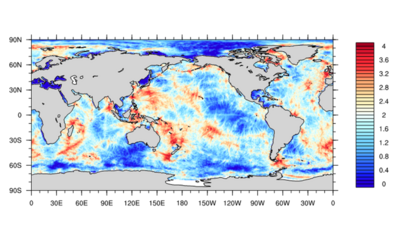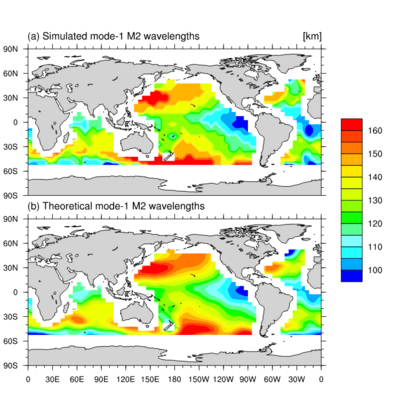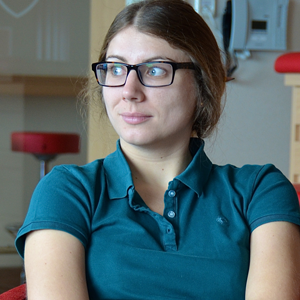Reports
Investigating internal wave energy fluxes
In my current work, I also look into the impact of mesoscale motion on the energy flux in this dataset.
My name is Jonas and I am a PhD Student in the subproject W2 “Low mode waves” in the working group Oceanography at the University Bremen. In this project I calculate low mode internal wave energy fluxes from mooring measurements and compare the results with measurements from satellite altimetry and a 1/10° ocean model (STORMTIDE2). Energy flux is an important quantity for these models because its divergence identifies sources and sinks.
Internal gravity waves occur all over the stratified ocean and can be grouped in different categories varying on their generation mechanism. I focus mainly on internal tides in the semidiurnal frequency M2 generated by the barotropic tides over rough topography. Internal tides are a response of the astronomical gravitational forces of the ocean via oscillations in the sea surface elevation with horizontal tidal currents through the entire water column. These waves in the stratified ocean take the form of standing vertical oscillations of horizontal currents, called modes. The “zeroth” (barotropic) mode of horizontal velocity corresponds to horizontal ocean currents that are uniform from top to bottom. The first depth dependent (baroclinic) mode is characterized by flow in one direction at the top and in the opposite direct at the bottom. Higher modes have a more complicated vertical structure and their phase speed decreases with increasing mode number. The vertical structure of a mode can be calculated by the stratification, and velocity profiles can be fitted onto a linear combination of these modes. Low mode motions contain appreciable energy but quickly propagate away laterally. To study these low mode internal waves, we deployed a mooring inside a tidal beam in the eastern North Atlantic, south of the Azores, where a seamount chain stands out as a generation site for internal tides. In our study region the energy flux correlates reasonably well in direction, coherent – uncoherent portioning and mode ratio between mooring and model time series and satellite data. With regard to the total energy flux, the model and satellite observations underestimate the flux compared to the in situ data.
In my current work, I also look into the impact of mesoscale motion on the energy flux in this dataset. A surface eddy was crossing the mooring, and in the process dampening the energy flux in the first two modes by about one third, while a passing subsurface eddy dampened the energy mainly in the second mode. These observations support the idea that eddy interactions transfer energy from low modes into higher modes that can lead to increased dissipation. An open question is how much of the energy converted from lower to higher modes result in local dissipation, which is a crucial information in creating energy consistent ocean-climate models.
The fate of low mode internal tides
The major goal of our subproject is to study the fate of low mode internal tides and the processes that operate along their pathways.
I am an observational physical oceanographer working as a Postdoc at the University Bremen. Prior to joining the TRR I mainly studied temporal variability of internal waves using time series of moored instruments, and related the observed changes in the internal wave energy to generation processes such as topography-current interaction or energy input into the internal wave field by the wind.
In the TRR I am part of the subproject W2 “Energy transfer through low mode internal waves”. Low mode internal waves possess a major part of the entire energy of the internal wave field, which makes them an important component of the oceanic energy pathways.
The major goal of our subproject is to study the fate of low mode internal tides and the processes that operate along their pathways. A seamount south of the Azores provides a good study case for these processes, as it is one of the main generation sites of internal tides in the Atlantic. Here we will conduct shipboard measurements and deploy a mooring for about one year to study spatial and temporal variability of internal tide energy. We will then compare the observed spatial and temporal variability along the tidal beam with output of dedicated runs of the STORMTIDE model carried out by our project partners at the MPI in Hamburg.

Propagation of long internal waves
The proper protocol and experiment setup for numerical experiments is crucial.
I am a postdoc at Max Planck Institute for Meteorology (MPI-M), working with Dr. Jin-Song von Storch. We care about the long internal waves in the ocean’s interior, which carry most of the internal wave energy. During their long-range propagation, their energy can be transferred to smaller scales, leading eventually to diapycnal mixing needed for supporting the global overturning circulation. Due to a lack of knowledge about the ultimate location and strength of their dissipation, their effect on mixing is generally parameterized by a spatially uniform diffusion in most ocean general circulation models (OGCMs). It is still a challenge to properly include their effects in OGCMs.
The high-resolution OGCMs, which directly resolve long internal waves (in addition to the general circulation), serve as an indispensable tool for investigating the fate of these waves. They allow us to study long internal waves in a realistic wave environment with realistic stratification and circulation. One such model is the 1/10° STORMTIDE model. This model simulates the long internal waves at tidal frequencies (internal tides) well (Fig. 1), in particular in regions where nonlinear interactions between internal tides and circulation are weak and linear waves predominate. This is reflected by the good agreement of the wavelengths of the most energetic mode simulated by the STORMTIDE model with those derived from linear theory (Fig. 2).
For the subproject W2, we will investigate the long internal waves generated by surface winds and tides within the same modeling framework. As a starting point, we analyze the global propagation of the long internal tides by using the energy flux simulated by the STORMTIDE model. This is a first step towards a better understanding of the sources and sinks of internal tides.




